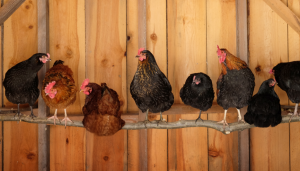When you’re building a chicken coop, one of the pieces of advice that you’ll find is to build your chickens a roost. You may wonder why your chickens need a roost. Isn’t that what nesting boxes are for? Let’s dive into why your chickens need a roost and how to create the perfect roost for them.
How Chickens Sleep
You know that your chicken coop will need nesting boxes, but you might not know that your chickens will need a roost also. Your chickens will not actually sleep in their nesting boxes. The nesting boxes are designed to give hens a safe space to lay their eggs, not to sleep in. So, why do chickens roost? And what does that mean?
Chickens are a prey animal in nature. They’re incredibly active during the day and sleep at night. Many of the predators that would attack chickens are active at night, while chickens are sleeping. To stay safe, chickens roost in trees or other elevated spaces that are harder to reach. Chicken coops are a new idea when you think about chickens over the past several thousand years. Chickens evolved a sleeping routine that would help to keep them safe. In fact, most birds sleep in trees or elevated spaces for the same reason. An exception to this is ducks, which sleep on the ground, close to water where they can make a quick escape if needed.

If your chickens were left to their own devices, they’d find a tree nearby that they would use as a roost. It’s also notable that chickens sleep sitting up. This upright position allows them to move quickly if needed. With that being said, most chickens that are roosting, AKA sleeping, are slow to move and react. If you need to catch a chicken for medical care or to put back into the coop, the best time to catch them is when they are roosting.
Creating the Ideal Roost
Now that you know your chickens need a roost to sleep comfortably, how do you go about creating a roost for them? If you’re building a coop from the ground up or just renovating an existing coop, you’ll want to create a roost that is comfortable for your chickens. A comfortable roost that is safe and well-designed will help to keep your coop cleaner and keep chickens from roosting (and pooping) in your nesting boxes. Dirty nesting boxes means dirty eggs, but you can easily avoid that problem by providing your chickens with ideal roosting spaces.
Chickens prefer to roost on bars that they can wrap their toes around. The ideal roost is about 2” in diameter. This is large enough that the toes can grab onto the roost without overlapping. You can make a roost out of many materials, but some of the cheapest and easiest to find are PVC and wood. You don’t have to spend a lot of money on a roost. In fact, some chicken owners use tree branches as roosts. Chickens really enjoy roosting on branches in the coop. This is what they would roost on in nature. If you’re going to use a tree branch, make sure that you remove limbs and sand down any places that could cut your chickens’ feet or leave splinters.
The roost should be set up on the opposite side of your coop from your nesting boxes. Chickens like to roost as high as possible, so you’ll want to set the roost up higher than the level of the nesting boxes in the coop. Cut your roosts to fit the length of the wall you want your chickens to roost on. Most of the time your chickens will roost in the coop. However, you can set up roosting spaces outside of the coop (but still in an enclosed run). This will give your chickens additional options for roosting and relaxing during the day.
Creating a roosting space for your chickens will help them to sleep more soundly and be overall healthier and happier